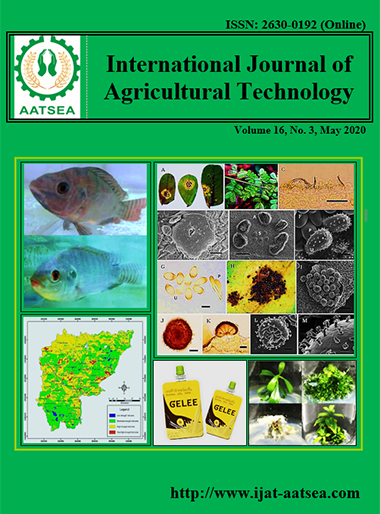Development of banana flavor carrageenan jelly drink fortified with banana peel extracts
Main Article Content
Abstract
The results from sensory evaluation with acceptance showed that the suitable gelling agent was carrageenan at level of 0.4 percent by weight, but after pasteurized jelly drink at 73oC 15 min, The hedonic score decreased at the term of banana flavor because that is not enough banana flavor. Thereafter, the optimal amount of banana puree and artificial banana flavoring were varied by the amount of banana puree added with artificial banana flavoring (puree: flavor). Five formulations for banana flavor carrageenan jelly drinks (100:0, 50:0.01, 50:0.02, 25:0.01, and 25:0.02) were evaluated in sensory characteristics with 9-point hedonic scale. The results showed that the most suitable formula of product was banana puree 50 percent and adding with artificial banana flavor 0.02 percent. Banana flavor carrageenan jelly drink fortified with banana peel extracts was a hardness value of0.59 Newton and the color L * a * and b * was 31.06 -2.86 and 22.81 respectively. The appropriate banana peel extracts content for adding in product was 1 percent with no difference from formulas without the extracts. In addition, it was found that banana peel extract gave 2,2-Diphenyl-1-1 picryhydrazyl (DPPH) radical scavenging activity (7.92 g sample/mol DPPH).
Article Details

This work is licensed under a Creative Commons Attribution-NonCommercial-NoDerivatives 4.0 International License.
References
Aboul-Enein, A. M., Salama, Z. A., Gaafar, A. A., Aly, H. F., Abou-Elella, F. and Ahmed, H. A. (2016). Identification of phenolic compounds from banana peel (Musa paradaisica L.) as antioxidant and antimicrobial agents. Journal of Chemical and Pharmaceutical Research, 8:46-55.
Černíková, M., Buňka, F., Pospiech, M., Tremlová, B., Hladká, K., Pavlínek, V. and Březina, P. (2010). Replacement of traditional emulsifying salts by selected hydrocolloids in processed cheese production. International Dairy Journal, 20:336–343. Retrieved from http://dx.doi.org/10.1016/j.idairyj.2009.12.012.
González-Montelongo, R., Gloria Lobo, M. and González, M. (2010). Antioxidant activity in banana peel extracts: Testing extraction conditions and related bioactive compounds. Food Chemistry, 119:1030-1039.
Jo, K. J., Cha, M. R., Lee, M. R., Yoon, M. Y. and Park, H. R. (2008). Methanolic extracts of uncaria rhynchophyllaInduce cytotoxicity and apoptosis in HT-29 human colon carcinoma cells. Plant Foods for Human Nutrition, 63:77-82.
Kumar, K. P. S., Bhowmik, D. Duraivel, S. and Umadevi, M. (2012). Traditional and medicinal uses of banana. Journal of Pharmacognosy and Phytochemistry, 1:51-63.
Ratnasari, D., Rustanti, N., Arifan, F. and Afifah, D. N. (2018). The effects of treatments on batu banana flour and percentage of wheat substitution on the resistant starch, in vitro starch digestibility content and palatability of cookies made with banana (Musa balbisiana Colla) flour. 3rd International Conference on Tropical and Coastal Region Eco Development 116:012003. Retrieved from http://doi :10.1088/1755-1315/116/1/012003.
Silva, B. A., Ferreres, F., Malva, J. O. and Dias, A. C. P. (2005). Phytochemical and antioxidant characterization of hypericumperforatum alcoholic extracts. Food Chemistry, 90:157-167.
Singh, S. and Prakash, P. (2015). Evaluation of antioxidant activity of banana peels (Musa acuminata) extracts using different extraction methods. Chemical Science Transactions, 4:158-160.
Soltani, M., Alimardani, R. and Omid, M. (2011). Evaluating banana ripening status from measuring dielectric properties. Journal of Food Engineering, 105:625-631.
Someya, S., Yoshiki, Y. and Okubo, K. (2002). Antioxidant compounds from bananas (Musa cavendish). Food Chemistry, 79:351-354.
Sulaiman, S. F., Yusoff, N. A. M., Eldeen, I. M., Seow, E. M., Sajak, A. A. B., Supriatna and Ooi, K. L. (2011). Correlation between total phenolic and mineral contents with antioxidant activity of eight malaysian bananas (Musa sp.). Journal of Food Composition and Analysis, 21:1-10.
Totosaus, A., Guerrero, I. and Montejano, J. G. (2005). Effect of added salts on textural properties of heatinduced gels made from gum-protein mixtures. Journal of Texture Studies 36:78-92.


